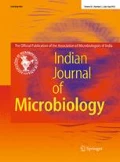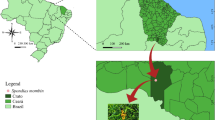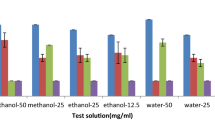Abstract
Various parts of Datura innoxia were examined for potential antibacterial activity by preparing their crude aqueous and organic extracts against Gram-negative bacteria (Escherichia coli and Salmonella typhi) and Gram-positive bacteria (Bacillus cereus, Bacillus subtilis and Staphylococcus aureus). The results of agar well diffusion assay indicated that the pattern of inhibition depends largely upon the plant part, solvent used for extraction and the organism tested. Extracts prepared from leaves were shown to have better efficacy than stem and root extracts. Organic extracts provided potent antibacterial activity as compared to aqueous extracts. Among all the extracts, methanolic extract was found most active against almost all the bacterial species tested. Gram-positive bacteria were found most sensitive as compared to Gram-negative bacteria. Staphylococcus aureus was signifi cantly inhibited by almost all the extracts even at very low MIC followed by other Gram-positives. For Escherichia coli (a Gram-negative bacterium), the end point was not reached for ethyl acetate extract while it was very high for other extracts. The study promises an interesting future for designing a potentially active antibacterial agent from Datura innoxia.
Similar content being viewed by others
References
Cohen ML (1992) Epidemiology of drug resistance, implications for a post antimicrobial era. Science 257:1050–1055
Gold SG and Moellering RC (1996) Antimicrobial drug resistance. N Engl J Med 335:1445–1453
Kaushik P (1985). Glimpses of medical botany in Atharvaveda. The Vedic Path 48(2):64–67
Nostro A, Germano MP, Angelo VD, Marino A and Cannatelli MA (2000) Extraction methods and bioautography for evaluation of medicinal plant antimicrobial activity. Letters in Applied Microbiology 30:379–384
Kaushik P and Dhiman AK (2000) Medicinal Plants and Raw Drugs of India. Bishen Singh Mahendra Pal Singh, New Cannaught Place, Dehradun
Samie A, Obi CL, Bessong PO and Namrita L (2005) Activity profiles of fourteen selected medicinal plants from rural Venda communities in South Africa against fifteen clinical bacterial species. African Journal of Biotechnology 4(12): 1443–1451
Kaushik P (1988) Indigenous Medicinal Plants including Microbes and Fungi. Today and Tomorrow’s Printers & Publishers, New Delhi
Figueiredo SFL and Esquibel MA (1991) Callogenesis, Organogenesis and Micropropagation of Datura insignis. Barb Rodr R Bras Fisiol Veg 3(2):63–98
NCCLS-National Committee for Clinical Laboratory Standards (1997b) Methods for Determining Bactericidal Activity of Antimicrobial Agents, Approved Standards M26-T, Wayne, Pa
NCCLS-National Committee for Clinical Laboratory Standards (1997a) Methods for Dilution Antimicrobial Susceptibility Tests for Bacteria that Grow Aerobically, Approved Standards M7-A4, Wayne, Pa
Akinpelu DA and Onakoya TM (2006) Antimicrobial activities of medicinal plants used in folklore remedies in south-western. African Journal of Biotechnology 5(11): 1078–1081
Dulger B (2006) Antimicrobial activity of some endemic Scrophulariaceae from Turkey. Pharmaceutical Biology 44(9):672–676
Dulger B, Kirmizi S, Arslan H, and Guleryuz G (2002) Antimicrobial activity of three endemic Verbascum species. Pharmaceutical Biology 40(8):587–589
Aliero AA and Afolayan AJ (2006) Antimicrobial activity of Solanum tomentosum. African Journal of Biotechnology 5(4):369–372
Kaushik P and Singh Y (2000) Antibacterial activity of extract of rhizome of Curcuma longa (turmeric). J Indian Bot Soc 79:191–192
Thongson C, Davidson PM, Mahakarnchanakul W, and Weiss J (2004) Antimicrobial activity of ultrasound-assisted solvent-extracted spices. Letters in Applied Microbiology 39:401–406
Gnan SO and Demello MT (1999) Inhibition of Staphylococcus aureus by aqueous Goiaba extracts. Journal of Ethnopharmacology 68(1–3):103–108
Eftekhar F, Yousefzadi M, and Tafakori V (2005) Antimicrobial activity of Datura innoxia and Datura stramonium. Fitoterapia 76:118–120
Author information
Authors and Affiliations
Rights and permissions
About this article
Cite this article
Kaushik, P., Goyal, P. In vitro evaluation of Datura innoxia (thorn-apple) for potential antibacterial activity. Indian J Microbiol 48, 353–357 (2008). https://doi.org/10.1007/s12088-008-0020-7
Received:
Accepted:
Published:
Issue Date:
DOI: https://doi.org/10.1007/s12088-008-0020-7




